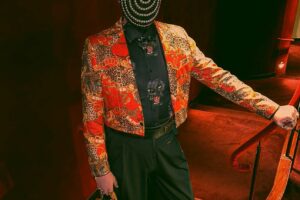
The case for this DVD production
of Puccini’s La Boheme from Opera Australia is all about the “inspired concept” of director Gale Edwards to move this oft-told tale from 1840’s Paris all the way to the Berlin at the end of Weimar-era Germany. Hmmm. I am a traditionalist at heart and confess to looking askance reading these liner notes until my mind started to erupt with the possibilities. Really, it’s all too, too, obvious.
The bohemians live in an attic— just like Anne Frank, right ? The Kit Kat Klub is an obvious stand-in for the Cafe Momus and how about a “Tomorrow Belongs to Me” Nazi Youth band for the finale of Act II, that would be sobering, huh? Act III at the Barriere d’enfer could be some kind of Nazi check-point replete with spies and villains and maybe a train headed you-know where. How about having Colline singing “Vecchia zimarra” to his coat with a yellow Star of David on it… Well, the possibilities are nearly endless, believe me, and while we’re on the subject, can we do Aida instead
I will list my numerous disappointments with the follow-through on this “Goodbye to Berlin” concept in a moment, but first a word on color-blind casting. Yes, I am a traditionalist. However, if you can sing the role I don’t care what color or shape you are, frankly, just take the stage. It’s up to the performer to inhabit and make me believe the part. My suspension of belief can handle a lot: I was a devotee of Jane Eaglen. So, even though our Rodolfo is Asian and our Mimi is African-American, the fact that there are a lot of Australians in this cast doesn’t bother me in the slightest.
Act I opens in the cleverly designed set of Brian Thomson which appears to be a 5-sided silo with a ring of glass bricks round the top, very Bauhaus. Our Marcello for the evening, the Argentine-born, Australian-bred, barihunk José Carbó is painting the Red Sea across the silo walls and it looks pretty spectacular, even unfinished. Our Rodolfo, Korean tenor Ji-Min Park, is busy burning his latest play in the makeshift stove that’s fashioned out of a tin drum.
They are joined by Australian bass David Parkin as Colline who looks more like he could have stumbled in from Seattle with the ubiquitous long hair, heavy coat, and knit cap. Then the double doors at the back fly open and Schaunard, played to the homo hilt by Australian bass Shane Lowrencev, flits in borne on his heightened fashion sense and a liberal use of his atomizer.
Parkin shows the sharpest comic timing of the four and Lowrencev is obviously relishing the flamboyance.The make-up plot for this production has everyone with a very pale base to resemble that silent movie look and, although this works to great effect for one character later on, it certainly doesn’t do our tenor any favors. Happily, this youthful cast all have youthful voices.
Mr. Park’s tenor seems a tad slim and has a slightly backward placement. He has the conversational quality necessary for Puccini but lacks the big bloom on the top of the voice that you really need to make an impression. The scene with Benoit, a very good John Bolton Wood, goes well and I’m eagerly awaiting the arrival of our Mimi, Ms. Takesha Meshé Kizart, whom I’ve been interested to hear in performance for a long time.
Her ‘Scusi ?’ from offstage is flat. Once she’s onstage, in her charming bobbed hairdo and a very flattering, 30’s style paneled dress, not only is her pitch consistently suspect but she’s apparently stole the loosley knitted shawl on her shoulders off of the dead body of Teresa Stratas from the Met production. There are moments when you think you might be hearing one of the most beautiful voices ever but, they are fleeting.
I have a friend whose litmus test for any Rodolfo is the phrase “Talor dal mio forziere.” If that goes well you have nothing to worry about for the rest of the evening and Park sings a fine “Che gelida manina.” Sliding effortlessly up to a lovely, and easy, high C. His Italian does show a slight accent at times and maybe the vestiges of having been learned by rote. His acting is genuine throughout and even manages some real tears later.
Ms. Kizart begins her aria and it’s immediately apparent she has just been endowed with an over abundance of voice and doesn’t have it under her control. Her tone isn’t centered and she tends to flat in the lower middle and upper middle at her register breaks. Part of this seems to be about how she produces her vowels on the ends of her range. She also has a glottal attack on the top that is the vocal equivalent of double clutching. She does have the big bloom on the top of the voice but she’s making the wrong impression. She even starts pulling down Mr. Park with her at times and I’m thinking all is lost. Act I ends with me, on the couch, disheartened.
Act II starts with the very colorful and decadent populace of Berlin out on the town and they’re utilizing the stage’s turntable to nice effect. Then, in the evenings sole stunning coup de theatre, the five panels of the silo all turn around simultaneously to reveal the balconied night club, all edged in lights. Pretty nifty. We’ve got some Kit Kat girls, half naked, lolling around for effect and some aristocratic types in nearly Gestapo uniforms.
The problem here is that almost immediately we get the little scene with Parpingnol, tenor Benjamin Rasheed, who’s surely the most horrifying, creepy-crawly, toy seller since Robert Helpmann in Chitty Chitty Bang Bang. Wait, what are all these little children doing in a dive nightclub? Ugh. I don’t want to know. Completely disturbing in the wrong way.
Mr. Park mostly misses on his second great opportunity, “Questa é Mimi,” which seems a bit beyond the reach of his very lyric instrument.
Then, the double doors open at the back of the stage and, we are visited by our evenings saviour in the form of Australian Diva in Excelsis, Taryn Fiebig, as Musetta. Stunningly gowned as Norma Desmond on her night off and topped with a platinum blonde short wave, she’s got that silent movie makeup plot with extra kohl under the eyes and it’s all working, working, working.
A waiter places one of those extra glam 1930’s microphones in front of her and she gives us a very lovely, note perfect, rendition of the Waltz. They even power up the turntable and the seated café patrons are revolving around her and I’m in heaven. Ms. Fiebig does not put a foot wrong for the rest of the evening. She understands her role and, most especially, the milieu of this production. Sadly, we only get a marching band of indeterminately costumed Girl Guides at the finale. Boo.
Act III and we are, indeed, at Checkpoint Charlie. I’m like Cassandra here, I swear. The five panels are now all chain link. A couple of scary guys in dark coats walking around with big guns and, lo and behold, someone walks on sporting a red armband that’s… blank ! Now, that just takes all the oomph out of it. I saw the last revival of Sound of Music on Broadway and right before the singing competition scene an enormous Nazi flag dropped down and covered the whole front of the stage. I have to tell you, as an audience member, a swastika will scare the stuffing out of you.
So, zero points to Opera Australia for not having the opera balls to give us some cold, hard, reality in this concept production. Oh, which reminds me, it’s so cold there is confetti twirling down from the theater flies. Not as bad as that year NYCO televised Boheme and they were using some sort of styrofoam snow and you couldn’t hear anything else because it was so loud, still it looks pretty ridiculous.
Our Mimi, Ms. Kizart, shows up in a thick winter coat and a head scarf for her duet with our Marcello, Mr. Carbó. Her pitch problems apparently can be explained by her worsening tuberculosis. She starts double clutching that top again and she makes some seriously unattractive sounds which is pretty difficult with a voice that plush. Mr. Park joins them and has apparently had some time to warm up. He covers himself with glory in the duet.
Then Ms. Kizart gives us a very large scale account of “Donde lieta usci,” larded with every human emotion imaginable and she’s dragging a weeping Mr. Park after her on his knees. At the end of the aria there’s no applause. None. My theory is that the whole thing was so overdone that there weren’t any emotions left for the audience to feel but ennui. A most excellent quartet and a leads to a naughty moment in the finale when Marcello and Musetta traipse way, way upstage starting to get (half) naked and having make-up sex (in the snow?)
Act IV of this extravaganza opens with Marcello putting the final touches on the Red Sea covering the silo walls. He and Mr. Park sing the duet very well together and Mr. Carbó is definitely a keeper, masculine good looks with a solid Verdi baritone. More of the Bohemian horsing about and then Musetta and Mimi arrive in full emergency room mode.
You can tell Ms. Kizart is near death because her hair is slightly askew and she’s forgotten to put on her lip gloss. This silo has never actually sported any proper furniture so now our Mimi is down on the floor on a dirty old futon resting her head against a ladder. Is this any way to treat a dying diva ? You all know how it ends and there are no surprises. I don’t want to ruin it for the younger readers.
Through all of this a masterful reading of the score by Taiwanese conductor Shao-Chia Lü who whips the orchestra into a frenzy and keeps them there the entire evening. You can see that lighting director, John Rayment has done a meticulous job but the camera is often too close in to capture the scale of his effects, which is a shame. The costumes of Julie Lynch really shine except, sadly, for the male principals who could have used something more individual. The very snazzy DVD packaging includes a souvenir booklet and impressive animated menus, of the production’s sets no less, almost like it’s a video game. Picture and DTS sound are excellent with very good balance.
Still, I’m not sure if this is a performance I’d return to— except for Ms. Fiebig’s few magnificent moments at the Kit Kat Klub.



























Comments